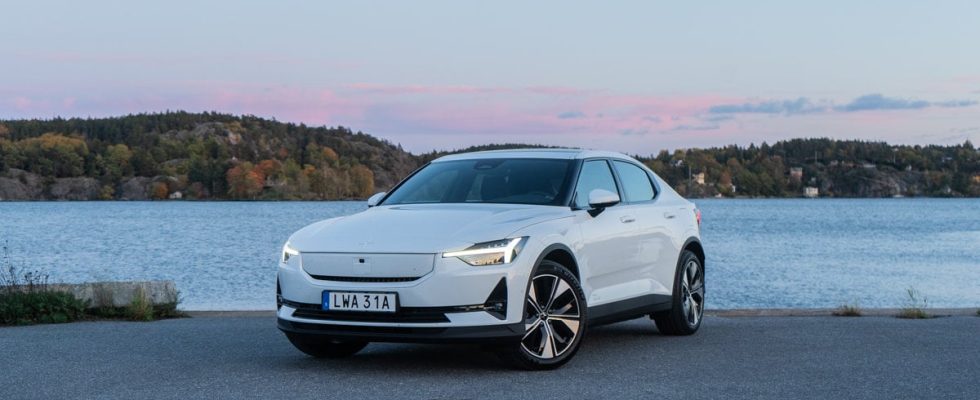The updates to the Polestar 2 are surprisingly comprehensive and include, among other things, that the electric car has a 22 percent longer range, 9 percent better efficiency, and charges 34 percent faster than the previous variant.
That’s as a result of a series of hardware updates – including a bigger battery. Another big news is that the entry-level model is now rear-wheel drive instead of front-wheel drive.
We have tested the Polestar 2 Long Range Single Motor, which offers a range of up to 655 kilometers according to WLTP.
To put the car to the test, we headed to Gothenburg with our sights set on Stockholm – just over 46 miles away – to see if the route can be driven without charging stops, even during normal driving.
We picked up the test car from Polestar in Gothenburg. (Photo: Marcus Berggren) A still attractive play
The cosmetic updates concerning the Polestar 2 are strictly limited to the grill, which now houses what the brand calls SmartZone. It is an area in the front where sensors, radar and camera are found.
The Polestar 2 remains a really attractive piece, and the design is successful, to say the least.
In terms of interior, Polestar has chosen to keep the existing 2 interior. It means a robust feel with high quality, with the exception of the area around the gear lever selector in piano black lacquer. However, the similarities with Volvo are striking.
The infotainment system is a Google story and thus works well. The system is intuitive and responsive, with good connectivity options.
Volvo EX30 test drive – an ergonomic darkness?
Polestar 2 looks really good. (Photo: Marcus Berggren) With a feather-light right foot
We used the car’s range assistant – which “provides the driver with clear information and assistance to facilitate more economical driving”.
Our driving consisted largely of highways, where we followed the speed limit to the letter – all in the name of range. That meant speed limits that mostly oscillated between 70 and 120 km/h.
Polestar has put a lot of effort into making the 2 impress purely in terms of driving dynamics, something that affects the car’s comfort level. The result is a bumpy experience, which is especially noticeable at lower speeds.
There is still a lot of noise that penetrates the cabin and at highway speeds you are met with a relatively unpleasant experience. Having said that, our car was completely unloaded and stuffing in the boot helps with some of the noise.
Another distraction is the semi-autonomous cruise control – Pilot Assist – which constantly reminds the driver to keep one hand on the wheel, even when you do.
Purely in terms of handling, however, the Polestar 2 is a joy to drive and the flat in the carpet is met with more cream than the performance figures suggest. It thus becomes difficult to recommend it four-wheel drive Performance variant.
We test the electric Lotus Eletre – the brand’s first SUV
Polestar 2 is quite sporty in itself. (Photo: Marcus Berggren) Cruise control all the way
Driving 460 kilometers with a car that on paper has a range of 655 kilometers should not be strange. It wasn’t either, but we arrived in central Stockholm with four percent battery left.
Consumption was 16.8 kWh per 100 kilometers for the number geeks reading this. The temperature in Gothenburg was around four degrees, but the sun shone all the way.
We kept to the exact speed limit all the way – something that is easier said than done as you usually act out of sync with other traffic.
If you are forced to stop charging, we can announce that the maximum fast charging is up to 205 kW, which is why the Polestar 2 is ideally suited as a long-distance electric car.
The government introduces a new environmental bonus
The interior is a robust story. (Photo: Marcus Berggren) Polestar 2 is a range finder of rank
Polestar 2 has the competitor Tesla right in the window. The Sino-Swedish brand offers an impressive overall product, especially if it is the rear-wheel drive model with the larger battery.
The problem lies in bumpy suspension and a noisy cabin at highway speeds. The Polestar 2 is actually a little too sporty for its own good, especially in entry-level trim, but that’s largely a matter of preference. The Tesla Model 3 is also not a comfort king for that matter.
Polestar 2 with rear-wheel drive and 655 kilometers shows that the brand can build convincing electric cars. The only question is whether it is enough to save the struggling car brand.
Dangerous: Road barriers are no match for heavy electric cars
The range is impressive. (Photo: Marcus Berggren) Rating of Polestar 2: 4/5
Polestar 2 Single Motor Long Range (2024)
Engine: An electric motor in the back, 299 horsepower, 490 newton meters
Transmission: 1-speed automatic transmission, rear wheel drive
Acceleration 0–100 km/h: 6.2 sec
Top speed: 205 km/h
Electrical range: 655 km
Weight: 1,828 kg
Dimensions (length/width/height): 4606/1985/1479mm
Award: From SEK 609,000
